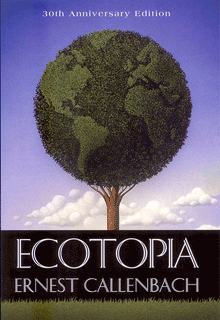Ernest Callenbach died the other day, at the ripe old age of 83. (Doesn’t actually seem that ripe when I’ve got friends in their 90s, but it’s at least a respectable total.) Callenbach was the author of the seminal 1975 book Ecotopia, which certainly had an effect on my thinking and my experience of the ’70s.
Ecotopia wasn’t very good as a novel; I remember thinking at the time that it felt like an account by a college freshman of his discovery of a life wider and more exciting than the one he’d grown up in. (It reminded me of “encounter groups” that I experienced when I was a college freshman myself in the late ’60s.) But it carries you along, keeping you interested enough in the characters to enjoy the story, while mostly presenting the society of Ecotopia that he had envisioned and invented. That vision of a radically environmentally sustainable society was what got people excited in the later 1970s.
Not long after I moved to Seattle, I signed up for a class at the Experimental College, a sort of officially unofficial adjunct to the University of Washington, on the concepts of Ecotopia. In that class I met a lot of people who were involved in trying to create a sustainable counterculture and asking themselves serious questions about how to really live in a place in modern North America. It tied in with ideas that I’d been reading and thinking about through writers such as Wendell Berry and Gary Snyder, and with currents of thought that were rife in the Pacific Northwest at that time. The concept of “Ecotopia” was very satisfying: it was a country comprising Washington, Oregon, and Northern California that had supposedly seceded from the United States and set up an ecologically based society with very little communication with the rest of the US. The precept of the novel is that an American reporter is finally able to penetrate Ecotopia and make a journey of discovery there. The story is told as entries in his diary.
Ecotopia is a utopian novel; so is Ursula K. Le Guin’s The Dispossessed, which came out shortly before Ecotopia. Although they are miles apart in literary quality, I remember intending to write a comparative review of the two books, because they took different, perhaps complementary, approaches to creating a fictional utopia. Le Guin’s Annares was a world of scarcity; Ecotopia, by contrast, was a world of abundance (the rich economy and ecology of northern California and the Pacific Northwest). Comparing the utopias, if not the novels, would have been enlightening.
After taking that Experimental College class in Ecotopia, I was so moved by the energy and the excitement among such a bunch of creative people that I and two other students from the class decided to continue it by teaching it ourselves the next quarter; and when we had done that, a couple of our own students did the same, taking the class and its community to a third quarter. (I don’t think it went farther than that.) There was a ferment at that time in environmental and “alternative” lifestyles and ideas on the West Coast, and the connections made through that class fueled a lot of creative activity in Seattle and environs for several years to come. We certainly didn’t create any utopias, but the study formed some of our perspectives and assumptions about the land we lived in and how we intended to go forward in our lives. Much of it later fell by the wayside, but some of it has persisted.
I only met Ernest Callenbach once, when he came through Seattle and visited our class to see what he had wrought. He seemed an unassuming man, who had simply had some good ideas at the right time and succeeded in expressing them in a way that people responded to. Before he wrote Ecotopia, he was better known as a film critic and the editor of Film Quarterly magazine. I remember his telling us that what had led him to writing Ecotopia was living in Berkeley and simply asking himself questions about where the waste went to. When he followed its route (intellectually, I assume, not literally), he realized that he was discovering a whole way of looking at the world.
You might think that Ernest Callenbach and Ecotopia don’t have much to do with design, which is the ostensible subject of this blog. But in the larger sense that we live in a designed world and ought to get better at it, this is very much at the heart of design.

